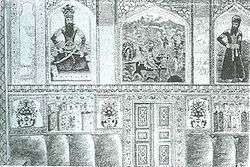Mirza Kadym Irevani
| Mirza Kadym Irevani | |
|---|---|
| Born |
Gadim Mammad Huseyn oglu 1825 Erivan, Khanate of Erevan, in part vassal[1] of Qajar Iran |
| Died |
1875 Erivan, Erivan Governorate, Russian Empire |
| Nationality | Azerbaijani |
| Known for | Panel painting |

Mirza Kadym Irevani,[2] (Azerbaijani: Mirzə Qədim Məmməd-Hüseyn oğlu İrəvani[3], 1825, Erivan — 1875, Erivan) was an Azerbaijani[4][5][6] ornamentalist artist and portraitist, founder of Azerbaijani panel painting, whose works greatly influenced Azerbaijani visual art of the modern period.[7]
Mirza Kadym Irevani is famed both for his pictures-stencils for embroidery, mural paintings, jewelry, lacquer paintings and glass paintings. His most famous works are portraits Sitting Woman,[8] Young man, Fath Ali Shah" and four big portraits painted in oil, in the 1850s, on the walls of the Palace of Erivan sardars.
Biography
Kadym Mammad Huseyn oglu was born in 1825, in the city Erivan in the Khanate of Erevan, Qajar Iran. He did not receive professional art education, and he became famous due his natural taste and talent.[9] Besides his artistic activity Irevani worked as a telegraphist at post office.
Creativity
Mirza Kadym Irevani's creativity evidences the origination of easel forms in Azerbaijani art. However some of his works, such as the portraits Sitting woman and Young man painted in watercolors and kept in Baku, in the Rustam Mustafayev Azerbaijan State Museum of Art were created in the middle of the 19th century and are more related to traditions of medieval miniature.
Irevani expressed great interest in human's view. He portrayed humans not against a conditional flat background, but on the three-dimensional space of the specific interior. Such a usage of volumetric-plastic modelling of the form and presentation of similarity with model evidenced of significant turn, which was noticed in Azerbaijani art of the modern period [10] and overcoming the traditions of conditionality and flatness of the picture.[11] Among the works of Mirza Gadim Irevani are famous pictures in the Palace of Sardar in Erivan, including four portraits of Fath Ali Shah, Abbas Mirza, Mah Tellet Khanim and Vajullah Mirza. Besides these works, the portrait of an unknown soldier was also painted. The palace was destroyed in 1914 (including four portraits on the walls of the palace) and the pictures of the portraits have only survived in copies.
Iravani's works, such as Female dancer (Azerbaijani: Rəqqasə), Darvish, Strongman (Azerbaijani: Pəhlivan), and Cavalryman (Azerbaijani: Süvari) are also famous.
Gallery
 Portraits in the Palace of Sardar in Irevan
Portraits in the Palace of Sardar in Irevan "Portrait of sitting woman", Tempera, 1870's, Rustam Mustafayev Azerbaijan State Museum of Art
"Portrait of sitting woman", Tempera, 1870's, Rustam Mustafayev Azerbaijan State Museum of Art
References
- ↑ Russia in the Nineteenth Century. Volume II of The History of Russia. Edited by M. V. Nechkina. 1953. P. 52
The khanates of Eastern Transcaucasia were in part semi-independent state structures and in part vassals of Iran, for instance the Khanate of Erevan, which had grown up on the territory of Armenia, or of Georgia, such as the Khanate of Ganja in Azerbaijan.
- ↑ Azerbaijan // The Grove Encyclopedia of Islamic Art and Architecture / Edited by Jonathan M. Bloom and Sheila Blair. — Oxford University Press, 2009. — V. II. — P. 239. — ISBN 9780195309911.
- ↑ Əfəndi R. (азерб.)русск. Azərbaycan incəsənəti. — Б.: Şərq-Qərb, 2007. — 160 с. — ISBN 978-9952-34-116-4.
- ↑ Миклашевская Н. М. Художники XIX в. Мирза Кадым Эривани и Мир Мохсун Навваб / Под ред. Полевого В. М.. — Искусство Азербайджана. — Баку, 1954. — Т. IV.
- ↑ Big Soviet Encyclopedia
- ↑ Эривани / Под ред. Полевого В. М.. — Популярная художественная энциклопедия. — М.: Советская энциклопедия, 1986.
- ↑ Миклашевская Н. М. Художники XIX в. Мирза Кадым Эривани и Мир Мохсун Навваб / Под ред. Полевого В. М.. — Искусство Азербайджана. — Баку, 1954. — Т. IV.
- ↑ "Эривани Мирза Кадым Мамед-Гусейн оглы". Академик.
- ↑ "Творчество М.К.Эривани нашедшее отражение в исследованиях К.Керимова.". ATI. 15.05.11. Check date values in:
|date=(help) - ↑ "Искусство Азербайджана".
- ↑ "Эривани Мирза Кадым Мамед-Гусейн оглы". Большая Советская Энциклопедия.